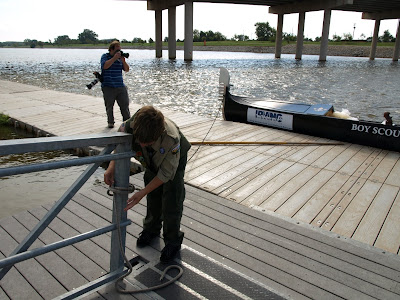It’s been a few days since Chris Harrison and I rowed the Oklahoma River.
And while I was “in recovery” for the first day or so, after that it was simply a matter of catching up on all the other areas of my life that I’d neglected.
Finally, I have time to report on last weekend’s adventure.
For weeks I’d been monitoring the weather around Oklahoma City.
My experience in Houston had shown that when it rains, bodies of water go from calm to crazy.
The recent introduction of Hurricane Ike made things even more interesting.
A storm that big can affect weather patterns all the way up to the Great Lakes region.
By the time we reached Oklahoma City, the rain had been falling, off and on for about a week,
This caused the river above the first dam to flow more.
Before I go further, it's important to understand the Oklahoma River.
It begins as the "North Canadian River", then, at a certain point, a dam was built. The North Canadian River is more of a stream, or a "drainage ditch", but with the dam, it fills up to a much wider, deeper waterway that is great for boating. They added another 2 or 3 dams, each with a lock system so boats can travel between the sections. After the last dam, the river goes back to being a "drainage ditch", and is once again called the “North Canadian River”. Only the section between the first dam and the last dam is called the "Oklahoma River". It was renamed in 2004.
The full length of the Oklahoma River is about 7 ½ miles.
Our plan was to row the entire length in both directions.
Once we were able to examine the river in-person, I realized that the portion of the river we were planning to row, didn’t really get moving like a normal river, mostly because it is partitioned, so one basin fills up, the water then spills into the next segment, which eventually fills before spilling into the next.
On the afternoon of the 11th (the day before the row), I was told that the folks at the Chesapeake Boathouse would be pulling all of their boats out of the water “to avoid all the debris” which would be floating down the river “once they opened the gates”.
It was a “this changes everything” moment.
It turns out that those “dams” that break up the river, can be opened hydraulically to allow unrestricted flow.
The rains up-river had been heavy enough that the authorities were planning to open things up…on the day we were going to row.
Could we still row the river?
I decided that the best approach would be to proceed, one section at a time, turning back if river conditions became dangerous.
We ended up covering two of the three sections, which amount to about 10 miles.
It was not exactly how I’d planned things, but I feel that we chose an approach that allowed us to cover the maximum amount of river while still handling things in a safe and responsible manner.
In all of my research, I heard everyone say the same thing: “there’s not a lot of wind on the Oklahoma River because it sits down so low”.
We had wind.
We had a lot of wind, often hitting us broadside, and requiring a number of adjustments to be made in order to keep moving forward.
In the end, we gave some good publicity to the Boy Scouts of America, and represented Venetian rowing well to the rowing and paddling community in Oklahoma.
Right after our arrival, we hauled out the gondola, checked out of our hotel early, and drove five hours back to Irving, Texas, where we launched the gondola – just in time as the effects of Hurricane Ike really came in after that. I would not have wanted to trailer the gondola down in that kind of weather.
 On Saturday, August 2rd, gondolier Matt Schenk and I brought the Phoenix up to Glendale for a TV commercial shoot.
On Saturday, August 2rd, gondolier Matt Schenk and I brought the Phoenix up to Glendale for a TV commercial shoot.















































